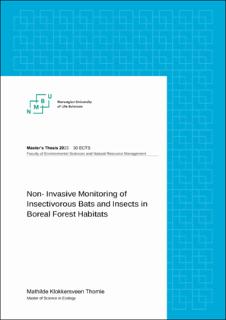Non-Invasive Monitoring of Insectivorous Bats and Insects in Boreal Forest Habitats
Master thesis
Permanent lenke
https://hdl.handle.net/11250/3076844Utgivelsesdato
2023Metadata
Vis full innførselSamlinger
- Master’s theses (MINA) [668]
Sammendrag
Abstract
1. All the Norwegian bat species depend on forest habitats in some parts of their annual cycle.Despite many of the Norwegian bat species being categorised as threatened on the NorwegianRed List and playing key roles as controllers of insect populations, lack of knowledge abouttheir ecological role in forests leads to them often being overlooked in management decisions.Bats can be grouped into foraging guilds depending on their foraging behaviors and callstructure. This study focuses on short- range echolocating (SRE) bat species foraging on insectsin open forest habitats.2. The overall aim of the study is to gain more knowledge about the relationships between SREbat activity and insect abundance within boreal forests of varying tree density. More specificallythis study investigates (1) if and how the activity of SRE bats is influenced by forest density(canopy openness) and environmental variables (temperature, moisture), and if theserelationships differs between feeding and commuting behaviours, (2) if and how the abundanceof insects is influenced by canopy openness and environmental variables, and (3) whether thereis a stronger positive correlation between bat feeding activity and insect abundance thanbetween bat commuting activity and insect abundance.3. Data was retrieved from sampling plots located in forest gaps in eleven mixed boreal forestsites in south-eastern Norway between May and September 2022. Bat activity and insectabundance were monitored with non- invasive methods, using bat acoustic detectors and insectcamera traps. Site- specific soil moisture and temperature data were sampled using data loggersdeployed into the soil. Hemisphere photos were taken at each site to calculate canopy opennessas a proxy for forest density.4. Results from this study show that forest density and environmental variables influenced batfeeding- and commuting activity differently. Bat feeding activity increased with higher canopyopenness and decreased with higher temperatures. Bat commuting activity decreased withincreasing soil moisture and temperatures. Insect abundance was positively influenced bymoisture and had a negative relationship with temperature. The relationship between batactivity and insect abundance was positively influenced by low canopy openness butdisappeared at higher openness. For commuting behaviour there was no clear relationshipbetween bats and insects. Results from this study show that there are relationships betweeninsect abundance and bat activity in forests that can be quantified with non- invasivemonitoring. However, to fully understand this relationship, one must account for the influenceof biotic and abiotic environmental variables.Key words: Insectivorous bats, flying insects, short- range echolocators, passive acousticmonitoring, insect camera traps, non- invasive, canopy openness, boreal forests
